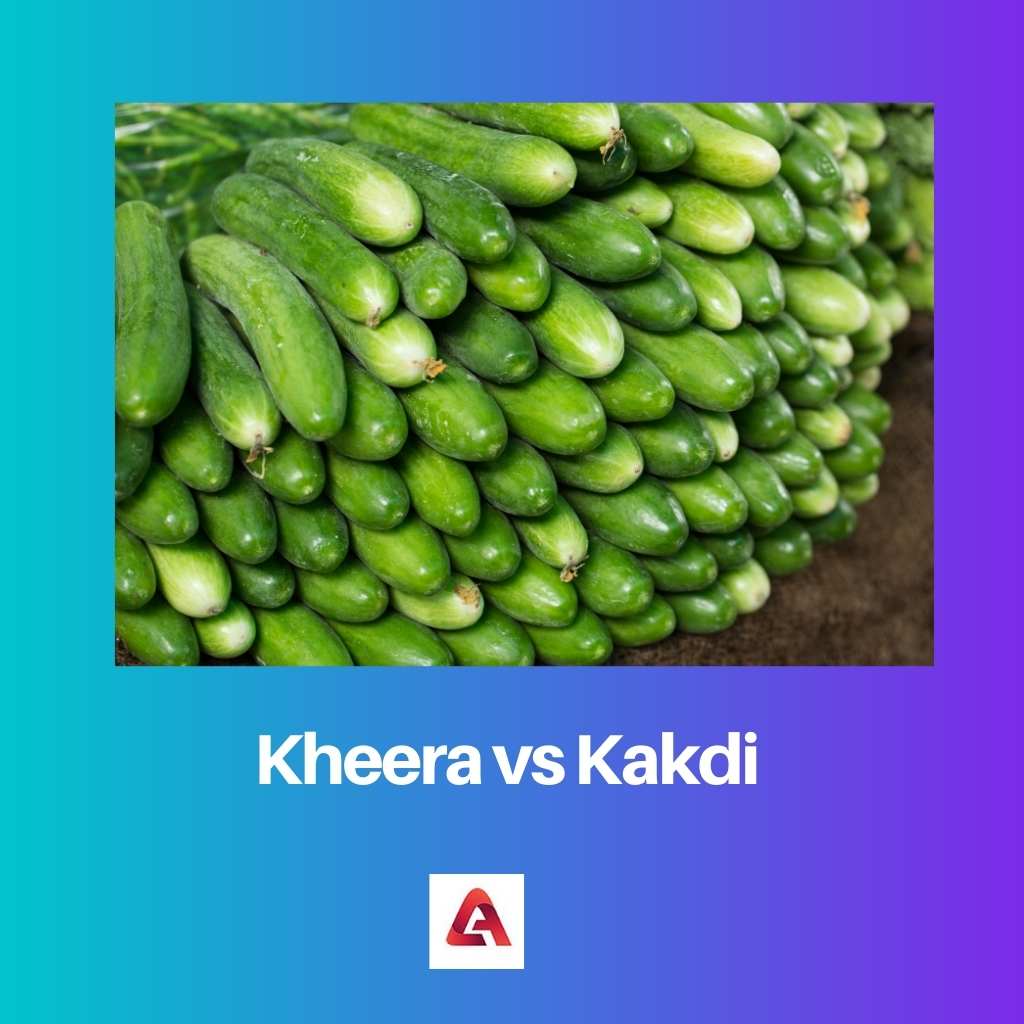Since the discovery of the cultivation of fruits and vegetables in the Stone Age, every generation has used different names to specify a particular vegetable.
But for someone not keen on cooking, these names can appear confusing. For instance, Kheera and Kakdi are vegetables that are confused.
These names are actively used in the Hindi or Marathi language we consider them to be the same, but they are different.
Key Takeaways
- Kheera is the common cucumber (Cucumis sativus), a widely consumed vegetable known for its refreshing taste and hydrating properties.
- Kakdi, also known as Indian cucumber (Cucumis melo var. utilissimus), is a less common, indigenous Indian variety with a slightly different taste and texture.
- Both vegetables belong to the same family, but kheera is more widely known and consumed globally, while kakdi is specific to Indian cuisine.
Kheera vs Kakdi
The difference between Kheera and Kakdi is that Kheera is popularly known as Cucumber, a plant that gives rise to a cylindrical vegetable. The cucumber is a creeping vine. On the other hand, Kakdi is popularly known as the Armenian Cucumber, which belongs to the family of melons. Kakdi is a long, slender fruit that appears strikingly similar to Cucumber yet is different in its way.

Kheera or Cucumber is an annual plant that originated in India as a creeping vine, a plant that starts growing from the ground and further grows with the help of support.
A Raw cucumber has many nutritional benefits, like vitamin K and an almost negligible amount of fat. Cucumber slightly tastes bitter due to Cucurbitacin.
On the other hand, we include Kakdi or Armenian Cucumber in the classification of a muskmelon. Due to its appearance (long, tapering ends), we also refer to it as snake melon or snake cucumber.
It is confused with snake gourd, but both differ in texture, taste, etc. We can grow it on a trellis or ground. The plant requires a lot of water to grow.
Comparison Table
| Parameters of Comparison | Kheera | Kakdi |
|---|---|---|
| Popular Name | Cucumber | Armenian Cucumber |
| Classified under | Cylindrical Fruits | Melons or Muskmelons |
| Height Range | 20-24 Inches | 12-15 Inches |
| Scientific Name | Cucumis sativus | Cucumis melo var. flexuosus |
| Used as | Vegetable (Salads) | Armenian Cucumber Pickles |
What is Kheera?
As aforementioned, Kheera (also called a cucumber) belongs to the family of Cucurbitaceae. It is a creeper plant that gives rise to a cylindrical fruit that is used as a vegetable.
Cucumber originated in India. In the Hindi language, we refer to it as Kheera. It is an annual plant and has several varieties grown currently.
Cucumber or Kheera originated in India about 3000 years ago. Kheera and other varieties of cucumber were found in the Indian Subcontinent.
It was introduced to the world by the Europeans. Thus, it became a staple worldwide. Presently, all countries worldwide grow many varieties of cucumber.
Being a creeper, the Cucumber plant can even grow in a soilless medium with enough water.
Owing to the flexibility concerning its cultivation, currently, there are numerous types of cucumbers grown globally, for instance, the Slicing, Gherkins, Pickling, and Seedless varieties.
Any cucumber can be used for preparing pickles, but we grow specific cucumbers for it, known as the Pickling Cucumbers or Picklers.
These cucumbers are comparatively short, with enough flesh, lack voids in the flesh, and are slightly irregular. The color of the cucumber can vary from green to pale yellow.
Along with this, Slicers and Seedless cucumbers are vital varieties. Slicers are long, uniform cucumbers that are devoured directly. Seedless cucumbers are sweeter, thin-skinned, and are popular in the markets.

What is Kakdi?
As mentioned above, Kakdi or Armenian Cucumber is a type of muskmelon that is strikingly similar to cucumbers yet differs in taste, texture, shape, etc. Kakdi is highly nutritious and is consumed raw or in salads.
It does not require processing like seedling or peeling. It can be cut into slices and consumed. The color of an Armenian Cucumber ranges from yellow-green to dark green.
The shape of a cucumber is curvy and not straight, like other cucumbers. These types of cucumbers are soft-skinned with smooth flesh that can be used for preparing pickles.
Pickled Armenian Cucumbers are popular in the Middle Eastern Market. They refer to it as Pickled Wild Cucumbers.
We can include Kakdi plants in the sunny plant’s classification. They require a high temperature 50-60 degrees (heat-tolerant) to grow and ripe well.
Since India is a tropical country, India is one of the top producers of Armenian Cucumbers. Also, this plant requires a sufficient amount of water to grow.
Best-flavoured Armenian Cucumbers grow up to 15-18 inches. But owing to the conditions they are cultivated in, they can grow up to 36 inches.
We can include them in the creeper plants that can grow well in-ground or on a trellis. These plants are only specific with the amount of sunlight and water; they need constant water while fruiting.
Taste-wise, Kakdi is never bitter and thus requires no processing. Along with this name, Kakdi is also called yard-long cucumber or snake cucumber; the designation varies with every country.

Main Differences Between Kheera and Kakdi
- Kheera is popularly known as Cucumber, whereas Kakdi is known as Armenian Cucumber.
- We can classify Kheera as a cylindrical fruit, while we classify Kakdi as a sub-category of muskmelon.
- The scientific name of Kheera is Cucumis sativus, whereas the scientific name of Kakdi is Cucumis melo var. Flexuosus.
- The average length of a Kheera is 24 Inches, whereas a Kakdi’s height can range from 15 to 36 inches.
- Kheera can grow even in low-water conditions, whereas Kakdi requires sufficient water to grow.
- Kheera should be peeled and is processed to remove the bitterness, whereas we can consume Kakdi directly.

References
- https://apply.jar.punjab.gov.pk/upload/1523508270_130_3._JAR_1173.pdf
- https://growables.com/informationVeg/documents/CucumberArmenian.pdf
